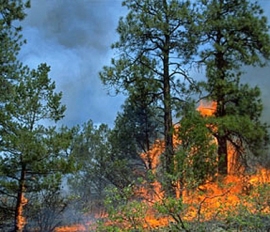Posted on May 17, 2012 by Bob Berwyn

A low-intensity ground fire burns through ponderosa pine during a prescribed fire in Grand Canyon National Park. PHOTO COURTESY NATIONAL PARK SERVICE.
New study offers more evidence that historical fire suppression is the main contributing factor in today’s big southwestern fires
By Summit Voice
SUMMIT COUNTY — A detailed analysis of historic fire-scar records and tree-ring data going back centuries offers more evidence that recent mega-fires in the Southwest are unprecedented and likely a result of widespread fire suppression.
While many of today’s southwestern forests haven’t seen a fire in more than 100 years, historical records show that, in the pre-suppression era, they rarely went as long as 40 or 50 years without a low-intensity ground fire.
To reach their conclusions, researchers at Southern Methodist University used a statistical model that encompassed 1,500 years of climate and fire patterns. They wanted to test if today’s dry, hot climate alone is causing the megafires that routinely destroy millions of acres of forest.
The results were striking. Year-to-year weather patterns that drive fire activity seemed to stay the same against the backdrop of larger climate cycles, according to SMU fire anthropologist Christopher I. Roos.
“The U.S. would not be experiencing massive large-canopy-killing crown fires today if human activities had not begun to suppress the low-severity surface fires that were so common more than a century ago,” said Roos, an assistant professor in the SMU Department of Anthropology.
No comments:
Post a Comment